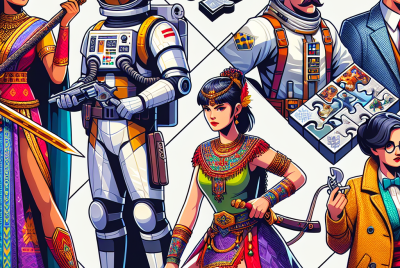The Pros and Cons of VR Gaming: A Future Perspective
The Pros and Cons of VR Gaming: A Future Perspective
Understanding VR Gaming
Virtual reality (VR) gaming has gained immense traction over the past few years. By immersing players in lifelike environments, VR technology provides an experience unlike traditional gaming. However, as with any technological advancement, there are both advantages and drawbacks associated with VR gaming. Below, we explore the pros and cons in depth.
Pros of VR Gaming
-
Immersive Experience
- VR gaming offers unparalleled immersion, allowing players to feel as if they are truly part of the game environment. This level of engagement can heighten emotional responses and increase the overall enjoyment of the gaming experience.
-
Physical Activity
- Many VR games incorporate physical movements, encouraging players to move around and interact with their surroundings. This can serve as a fun form of exercise, contrasting with traditional sedentary gameplay and contributing to overall fitness.
-
Enhanced Social Interaction
- VR platforms often include multiplayer capabilities, enabling players to interact in virtual spaces. This fosters social connections, allowing friends and gamers around the world to collaborate or compete in real-time, enhancing community and teamwork.
-
Innovative Gameplay Mechanics
- With VR, developers can create innovative gameplay mechanics that are difficult to achieve in traditional formats. Features such as hand tracking and spatial awareness provide a new layer of interactivity, allowing for more creative and engaging game designs.
-
Therapeutic Applications
- Aside from entertainment, VR gaming is being utilized in therapeutic settings, such as rehabilitation and anxiety management. Immersive environments can help patients confront fears or recover from physical injuries through engaging exercises.
-
Educational Opportunities
- Educational VR games can enhance learning experiences. By placing users in historical events or scientific scenarios, these games make complex subjects more accessible and engaging, transforming education into an interactive journey.
-
Improved Storytelling
- The immersive nature of VR allows for storytelling that is both engaging and interactive. Players can explore narratives in complex worlds, making choices that influence outcomes, which creates a more personalized gaming experience.
-
Hardware Evolution
- The continual advancement of VR hardware promises better visual fidelity, responsiveness, and comfort. As technology progresses, players can expect experiences that are increasingly lifelike, reducing motion sickness and enhancing enjoyment.
-
Diverse Genre Exploration
- VR gaming caters to various genres, from horror to simulation, allowing a wide range of interests to be explored. This diversity makes VR appealing to different demographics and encourages players to indulge in new experiences.
-
Development of Skills
- Many VR games require the use of hand-eye coordination and problem-solving skills. Players often experience improvements in cognitive functions and spatial awareness, which can translate to real-life scenarios.
Cons of VR Gaming
-
High Entry Costs
- The cost of VR hardware can be a significant barrier to entry for many potential players. High-quality VR headsets, compatible gaming systems, and accessories require a considerable investment, making it less accessible.
-
Physical Discomfort
- Extended playtime in VR can lead to physical discomfort, including eye strain and dizziness. Some players may experience motion sickness, particularly when the game’s movement doesn’t align with their own bodily sensations.
-
Space Requirements
- VR gaming often necessitates a clear and spacious area for players to move around freely. Limited space can hinder the immersive experience and may restrict potential gameplay opportunities, making it difficult for some users to fully engage.
-
Social Isolation
- Despite the potential for enhanced social interaction, VR can also lead to feelings of isolation, particularly for players who spend excessive amounts of time in virtual worlds. This could hinder real-life connections and relationships.
-
Limited Game Library
- While the library of VR games is growing, it is still significantly smaller than traditional console and PC games. This could make it challenging for players to find a diverse selection of titles that align with their interests.
-
Technical Issues
- VR gaming can sometimes be plagued by technical challenges such as lag, glitches, and software crashes. These issues can detract from the immersive experience and lead to player frustration.
-
Non-Universal Compatibility
- Different VR systems often lack compatibility with each other, requiring players to invest in specific hardware for specific titles. This fragmentation can confuse potential buyers and limit cross-platform play.
-
Steep Learning Curve
- Some VR games have complex controls and mechanics that may overwhelm new players. The learning curve can be steep, making it less appealing for those who prefer casual gaming experiences.
-
Safety Concerns
- Engaging in VR can lead to accidents when players become too absorbed in the experience and forget their surroundings. Without proper awareness of physical space, users risk injury or damage to their environment.
-
Psychological Effects
- Prolonged exposure to virtual environments may lead to desensitization or an altered perception of reality for some players. This alteration can have unintended psychological effects, particularly for younger audiences whose perceptions are still developing.
Future Perspective on VR Gaming
As we look to the future, the debate between the pros and cons of VR gaming continues to evolve. Promising advancements in technology, such as improved motion tracking, better graphics, and wireless capabilities, are likely to mitigate many current disadvantages. As hardware becomes more affordable and user-friendly, the barriers to entry may decrease, allowing a broader audience to experience the joys of VR gaming.
Simultaneously, as awareness grows regarding the potential psychological and physical implications, the industry must prioritize safety protocols and regulations. By addressing technical limitations and enhancing game libraries, companies can better meet player expectations and needs.
Additionally, the fusion of VR with other emerging technologies, like artificial intelligence, could lead to even more immersive experiences, tailoring content to individual preferences and enhancing the overall gaming landscape.
The journey of VR gaming is just beginning, and as it transitions into a mainstream avenue of entertainment, its future relies on balancing innovative possibilities with the responsibility of creating enjoyable, safe experiences for all users. Understanding the landscape of VR gaming today sets the stage for appreciating its potential tomorrow.




